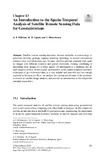Mostrar el registro sencillo del ítem
An introduction to the spatio-temporal analysis of satellite remote sensing data for geostatisticians
| dc.creator | Militino, Ana F. | es_ES |
| dc.creator | Ugarte Martínez, María Dolores | es_ES |
| dc.creator | Pérez Goya, Unai | es_ES |
| dc.date.accessioned | 2019-11-12T13:50:14Z | |
| dc.date.available | 2019-11-12T13:50:14Z | |
| dc.date.issued | 2018 | |
| dc.identifier.uri | https://hdl.handle.net/2454/35352 | |
| dc.description.abstract | Satellite remote sensing data have become available in meteorology, agriculture, forestry, geology, regional planning, hydrology or natural environment sciences since several decades ago, because satellites provide routinely high quality images with different temporal and spatial resolutions. Joining, combining or smoothing these images for a better quality of information is a challenge not always properly solved. In this regard, geostatistics, as the spatiotemporal stochastic techniques of georeferenced data, is a very helpful and powerful tool not enough explored in this area yet. Here, we analyze the current use of some of the geostatistical tools in satellite image analysis, and provide an introduction to this subject for potential researchers. | en |
| dc.description.sponsorship | This research was supported by the Spanish Ministry of Economy, Industry and Competitiveness (Project MTM2017-82553-R), the Government of Navarra (Project PI015, 2016 and Project PI043 2017), and by the Fundación Caja Navarra-UNED Pamplona (2016 and 2017). | en |
| dc.format.extent | 15 p. | |
| dc.format.mimetype | application/pdf | en |
| dc.language.iso | eng | en |
| dc.publisher | Springer International Publishing | en |
| dc.relation.ispartof | B. S. Daya Sagar et al. (eds.), Handbook of Mathematical Geosciences: Fifty Years of IAMG. e-ISBN 978-3-319-78999-6. P. 239-253 | en |
| dc.rights | © The Author(s) 2018. This chapter is licensed under the terms of the Creative Commons Attribution 4.0 International License, which permits use, sharing, adaptation, distribution and reproduction in any medium or format, as long as you give appropriate credit to the original author(s) and the source, provide a link to the Creative Commons license and indicate if changes were made. The images or other third party material in this chapter are included in the chapter’s Creative Commons license, unless indicated otherwise in a credit line to the material. If material is not included in the chapter’s Creative Commons license and your intended use is not permitted by statutory regulation or exceeds the permitted use, you will need to obtain permission directly from the copyright holder. | en |
| dc.rights.uri | http://creativecommons.org/licenses/by/4.0/ | |
| dc.subject | Satellites | en |
| dc.subject | Image analysis | en |
| dc.subject | Remote sensing datas | en |
| dc.title | An introduction to the spatio-temporal analysis of satellite remote sensing data for geostatisticians | en |
| dc.type | info:eu-repo/semantics/bookPart | en |
| dc.type | Capítulo de libro / Liburuen kapitulua | es |
| dc.contributor.department | Estadística, Informática y Matemáticas | es_ES |
| dc.contributor.department | Estatistika, Informatika eta Matematika | eu |
| dc.contributor.department | Institute for Advanced Materials - INAMAT | es_ES |
| dc.rights.accessRights | info:eu-repo/semantics/openAccess | en |
| dc.rights.accessRights | Acceso abierto / Sarbide irekia | es |
| dc.identifier.doi | 10.1007/978-3-319-78999-6_13 | |
| dc.relation.projectID | info:eu-repo/grantAgreement/AEI/Plan Estatal de Investigación Científica y Técnica y de Innovación 2013-2016/MTM2017-82553-R/ES/ | en |
| dc.relation.publisherversion | https://doi.org/10.1007/978-3-319-78999-6_13 | |
| dc.type.version | info:eu-repo/semantics/publishedVersion | en |
| dc.type.version | Versión publicada / Argitaratu den bertsioa | es |
| dc.contributor.funder | Gobierno de Navarra / Nafarroako Gobernua | es |
Ficheros en el ítem
Este ítem aparece en la(s) siguiente(s) colección(ones)
La licencia del ítem se describe como © The Author(s) 2018. This chapter is licensed under the terms of the Creative Commons Attribution 4.0
International License, which permits use, sharing,
adaptation, distribution and reproduction in any medium or format, as long as you give appropriate
credit to the original author(s) and the source, provide a link to the Creative Commons license and
indicate if changes were made.
The images or other third party material in this chapter are included in the chapter’s Creative
Commons license, unless indicated otherwise in a credit line to the material. If material is not
included in the chapter’s Creative Commons license and your intended use is not permitted by
statutory regulation or exceeds the permitted use, you will need to obtain permission directly from
the copyright holder.



